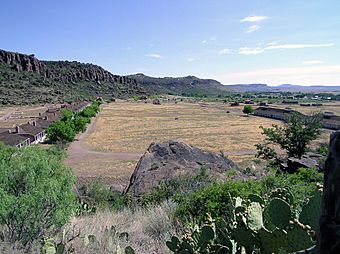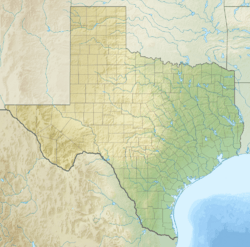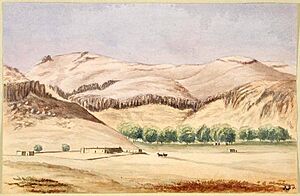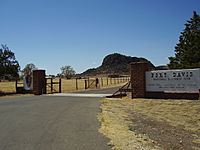Fort Davis National Historic Site facts for kids
|
Fort Davis National Historic Site
|
|

Fort Davis National Historic Site
|
|
| Location | 101 Lt. Flipper Dr. Fort Davis, Texas |
|---|---|
| Area | 523 acres (212 ha) |
| Built | 1854 |
| Architect | Lt. Col. Wesley Merritt |
| Visitation | 55,955 (2015) |
| Website | Fort Davis National Historic Site |
| NRHP reference No. | 66000045 |
Quick facts for kids Significant dates |
|
| Added to NRHP | October 15, 1966 |
| Designated NHL | December 19, 1960 |
| Designated NHS | September 8, 1961 |
Fort Davis National Historic Site is a special place in Texas. It's a National Historic Site that protects an old United States Army fort. You can find it in Fort Davis, a small community in West Texas. This site was created in 1961. Its main goal is to save one of the best examples of an old army fort in the southwestern United States.
Contents
History of Fort Davis
Why Fort Davis Was Built
Fort Davis was started in October 1854. It was built by Bvt. Maj. Gen. Persifor Frazer Smith. The fort was named after Jefferson Davis, who was the Secretary of War at the time. Later, he became the President of the Confederate States of America. The fort was placed in a canyon. This location helped protect the soldiers from cold winter winds.
Protecting the Frontier
From 1854 to 1891, Fort Davis was very important. It helped keep people safe who were traveling through Texas. These travelers included settlers, mail coaches, and wagons carrying goods. The fort also helped control important trails. These were used by the Comanche and Mescalero Apache people.
Fort Davis During the Civil War
In April 1861, the fort was emptied. This happened at the start of the Civil War. Only a few Confederate States Army soldiers stayed to guard it. In August 1861, Mescalero Apaches attacked a nearby cattle pen. During the chase, most of a patrol of soldiers were killed. This event led the Confederates to send more soldiers to the fort. However, the Confederates left the fort for good in August 1862.
The Buffalo Soldiers Arrive
After the Civil War, the U.S. Army returned to Fort Davis in 1867. This fort is famous for the "buffalo soldiers." These were all-black regiments of soldiers. They were formed after the Civil War. The 24th and 25th U.S. Infantry and the 9th and 10th U.S. Cavalry regiments were stationed here. Lt. Col. Wesley Merritt led some of these soldiers in rebuilding the fort. They used limestone and adobe to construct new buildings.
Visiting Fort Davis Today
What You Can See
Today, Fort Davis National Historic Site has 24 restored buildings. There are also more than 100 ruins and foundations. Five of the buildings look just like they did in the 1880s. This helps visitors imagine what life was like back then. You can start your visit at the visitor center. From there, you can take a self-guided tour.
Learning About the Past
During the summer, you might see Living history demonstrations. These are people dressed up in old uniforms. They show what daily life was like at the fort. Fort Davis became part of the National Park System in 1961. It was also named a National Historic Landmark in 1960.
The Legend of Indian Emily
There is a memorial at Fort Davis for a brave young woman named Indian Emily. She is the subject of a popular legend. The story says that Emily saved the fort from an Apache attack. She loved a young officer and warned the fort of danger. Sadly, she was accidentally shot and died.
Gallery
See also








